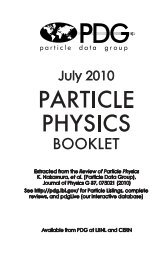30. Passage of particles through matter 1 - Particle Data Group
30. Passage of particles through matter 1 - Particle Data Group
30. Passage of particles through matter 1 - Particle Data Group
You also want an ePaper? Increase the reach of your titles
YUMPU automatically turns print PDFs into web optimized ePapers that Google loves.
30 <strong>30.</strong> <strong>Passage</strong> <strong>of</strong> <strong>particles</strong> <strong>through</strong> <strong>matter</strong><br />
lengths are increased via the mechanisms discussed above.<br />
The gamma function distribution is very flat near the origin, while the EGS4<br />
cascade (or a real cascade) increases more rapidly. As a result Eq. (<strong>30.</strong>34) fails<br />
badly for about the first two radiation lengths; it was necessary to exclude this<br />
region in making fits.<br />
Because fluctuations are important, Eq. (<strong>30.</strong>34) should be used only in<br />
applications where average behavior is adequate. Grindhammer et al. have<br />
developed fast simulation algorithms in which the variance and correlation <strong>of</strong><br />
a and b are obtained by fitting Eq. (<strong>30.</strong>34) to individually simulated cascades,<br />
then generating pr<strong>of</strong>iles for cascades using a and b chosen from the correlated<br />
distributions [58].<br />
The transverse development <strong>of</strong> electromagnetic showers in different materials<br />
scales fairly accurately with the Molière radius RM, given by [59,60]<br />
RM = X0 Es/Ec , (<strong>30.</strong>36)<br />
where Es ≈ 21 MeV (Table <strong>30.</strong>1), and the Rossi definition <strong>of</strong> Ec is used.<br />
In a material containing a weight fraction wj <strong>of</strong> the element with critical energy<br />
Ecj and radiation length Xj, the Molière radius is given by<br />
1<br />
=<br />
RM<br />
1 � wj Ecj<br />
. (<strong>30.</strong>37)<br />
Es Xj<br />
Measurements <strong>of</strong> the lateral distribution in electromagnetic cascades are shown<br />
in Refs. 59 and 60. On the average, only 10% <strong>of</strong> the energy lies outside the<br />
cylinder with radius RM. About 99% is contained inside <strong>of</strong> 3.5RM, but at this<br />
radius and beyond composition effects become important and the scaling with RM<br />
fails. The distributions are characterized by a narrow core, and broaden as the<br />
shower develops. They are <strong>of</strong>ten represented as the sum <strong>of</strong> two Gaussians, and<br />
Grindhammer [58] describes them with the function<br />
f(r) =<br />
2r R2<br />
(r2 + R2 , (<strong>30.</strong>38)<br />
) 2<br />
where R is a phenomenological function <strong>of</strong> x/X0 and ln E.<br />
At high enough energies, the LPM effect (Sec. <strong>30.</strong>4.5) reduces the cross sections<br />
for bremsstrahlung and pair production, and hence can cause significant elongation<br />
<strong>of</strong> electromagnetic cascades [43].<br />
June 18, 2012 16:19







